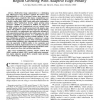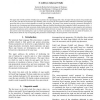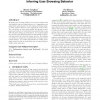873 search results - page 42 / 175 » Language model adaptation using Random Forests |
ICRA
2003
IEEE
14 years 2 months ago
2003
IEEE
— As people move through their environments, they do not move randomly. Instead, they are often engaged in typical motion patterns, related to specific locations they might be i...
TIP
2010
13 years 3 months ago
2010
Multivariate image segmentation is a challenging task, influenced by large intraclass variation that reduces class distinguishability as well as increased feature space sparseness ...
LREC
2010
13 years 10 months ago
2010
This paper deals with the problem of finding sign occurrences in a sign language (SL) video. It begins with an analysis of sign models and the way they can take into account the s...
MODELS
2009
Springer
14 years 3 months ago
2009
Springer
The proliferation of smart spaces and emergence of new standards, such as Web Services, have paved the way for a new breed of software systems. Often the complete functional and Qo...
SIGIR
2012
ACM
11 years 11 months ago
2012
ACM
Modeling user browsing behavior is an active research area with tangible real-world applications, e.g., organizations can adapt their online presence to their visitors browsing be...



